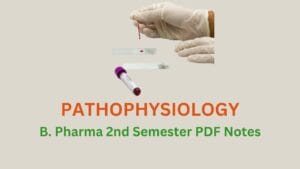Pathophysiology B. Pharma 2nd Semester PDF Notes

Pathophysiology:
Pathophysiology is the study of the physiological processes and mechanisms underlying disease or abnormal conditions in the body. It focuses on understanding how the body’s normal functions are disrupted or altered during disease states. Here are some key points about pathophysiology:
Disease Processes: Pathophysiology investigates the mechanisms by which diseases develop and progress. It explores the cellular, biochemical, and physiological changes that occur in the body when it is affected by a particular disease or condition.
Homeostasis: The body maintains a state of balance called homeostasis, where various systems work together to keep internal conditions stable. Pathophysiology examines how diseases disrupt this equilibrium and lead to pathological changes.
Causes and Risk Factors: Pathophysiology helps identify the causes and risk factors associated with diseases. It explores genetic, environmental, lifestyle, and other factors that contribute to the development of diseases and their progression.
Sign and Symptoms: Understanding pathophysiology provides insights into the signs and symptoms exhibited by individuals with a specific disease. It helps in recognizing the underlying mechanisms responsible for these clinical manifestations.
Diagnosis and Treatment: Pathophysiological knowledge is essential for accurate diagnosis and effective treatment of diseases. By understanding the underlying mechanisms, healthcare professionals can develop targeted interventions and therapies to restore normal physiological functions.
Disease Progression: Pathophysiology studies the natural course of diseases, including how they progress and evolve over time. It helps in predicting disease outcomes and understanding the complications that may arise during the course of the illness.
Research and Advancements: Pathophysiology research contributes to advancements in medical knowledge and the development of new treatments. It provides a foundation for understanding disease processes and aids in the discovery of novel therapeutic approaches.
Scope: Pathophysiology b pharm 2nd semester is the study of causes of diseases and reactions of the body to such disease-producing causes. This course is designed to impart a thorough knowledge of the relevant aspects of pathology of various conditions with reference to its pharmacological applications, and understanding of basic pathophysiological mechanisms. Hence it will not only help to study the syllabus of pathology but also get the baseline knowledge required to practice medicine safely, confidently, rationally, and effectively.
Objectives: Upon completion of the subject student shall be able to –
- Describe the etiology and pathogenesis of the selected disease states;
- Name the signs and symptoms of the diseases; and
- Mention the complications of the diseases.
Course content:
PATHOPHYSIOLOGY Unit I
Basic Principles of Cell Injury and Adaptation:
Introduction, definitions, Homeostasis, Components and Types of Feedback systems, Causes of cellular injury, Pathogenesis (Cell membrane damage, Mitochondrial damage, Ribosome damage, Nuclear damage), Morphology of cell injury – Adaptive changes (Atrophy, Hypertrophy, hyperplasia, Metaplasia, Dysplasia), Cell swelling, Intra cellular accumulation, Calcification, Enzyme leakage and Cell Death Acidosis & Alkalosis, Electrolyte imbalance
Basic mechanism involved in the process of inflammation and repair:
Introduction, Clinical signs of inflammation, Different types of Inflammation, Acute Inflammation, Chronic Inflammation, Chemical Mediator of Inflammation, Mechanism of Inflammation – Alteration in vascular permeability and blood flow, migration of WBC’s, Mediators of inflammation, Basic principles of wound healing in the skin, Pathophysiology of Atherosclerosis, Wound healing.
Pathophysiology B Pharmacy Notes Unit II
Cardiovascular System:
Hypertension, congestive heart failure, ischemic heart disease (angina, myocardial infarction, atherosclerosis and arteriosclerosis)
Respiratory system: Asthma, Chronic obstructive airways diseases.
Renal system: Acute and chronic renal failure.
Pathophysiology B Pharmacy Notes Unit III
Hematological Diseases:
Iron deficiency Anemia, megaloblastic anemia (Vit B12 and folic acid), sickle cell anemia, thalasemia, hereditary acquired anemia, hemophilia.
Endocrine system: Diabetes, Complication of Diabetes, thyroid diseases, disorders of sex hormones: Erectile Dysfunction, Infertility,
Nervous system: Epilepsy, Parkinson’s disease, Stroke, psychiatric disorders: depression, schizophrenia and Alzheimer’s disease.
Gastrointestinal system: Peptic Ulcer
Pathophysiology B Pharmacy Notes Unit IV
Inflammatory bowel diseases, jaundice, hepatitis (A,B,C,D,E,F) alcoholic liver disease.
Disease of bones and joints: Rheumatoid arthritis, osteoporosis and gout (Acute and Chronic Gout)
Principles of cancer: classification, etiology and pathogenesis of cancer
Pathophysiology B Pharmacy Notes Unit V
Infectious diseases: Meningitis, Typhoid, Leprosy, Tuberculosis
Sexually transmitted diseases: AIDS, PCOS, Syphilis, Gonorrhea
Pathophysiology Recommended Books (Latest Editions)
- Vinay Kumar, Abul K. Abas, Jon C. Aster; Robbins &Cotran Pathologic Basis of Disease; South Asia edition; India; Elsevier; 2014.
- Harsh Mohan; Text book of Pathology; 6th edition; India; Jaypee Publications; 2010.
- Laurence B, Bruce C, Bjorn K. ; Goodman Gilman’s The Pharmacological Basis of Therapeutics; 12th edition; New York; McGraw-Hill; 2011.
- Best, Charles Herbert 1899-1978; Taylor, Norman Burke 1885-1972; West, John B (John Burnard); Best and Taylor’s Physiological basis of medical practice; 12th ed; united states;
- William and Wilkins, Baltimore; 1991 [1990 printing].
- Nicki R. Colledge, Brian R. Walker, Stuart H. Ralston;Davidson’s Principles and Practice of Medicine; 21st edition; London; ELBS/Churchill Livingstone; 2010.
- Guyton A, John .E Hall; Textbook of Medical Physiology; 12th edition; WB Saunders Company; 2010.
- Joseph DiPiro, Robert L. Talbert, Gary Yee, Barbara Wells, L. Michael Posey; Pharmacotherapy: A Pathophysiological Approach; 9th edition; London; McGraw-Hill Medical; 2014.
- V. Kumar, R. S. Cotran and S. L. Robbins; Basic Pathology; 6th edition; Philadelphia; WB Saunders Company; 1997.
- Roger Walker, Clive Edwards; Clinical Pharmacy and Therapeutics; 3rd edition; London; Churchill Livingstone publication; 2003.
Pathophysiology Recommended Journals
- The Journal of Pathology. ISSN: 1096-9896 (Online)
- The American Journal of Pathology. ISSN: 0002-9440
- Pathology. 1465-3931 (Online)
- International Journal of Physiology, Pathophysiology, and Pharmacology. ISSN: 1944-8171 (Online)
- Indian Journal of Pathology and Microbiology. ISSN-0377-4929.
1 thought on “Pathophysiology – B. Pharma 2nd Semester PDF Notes”
Comments are closed.